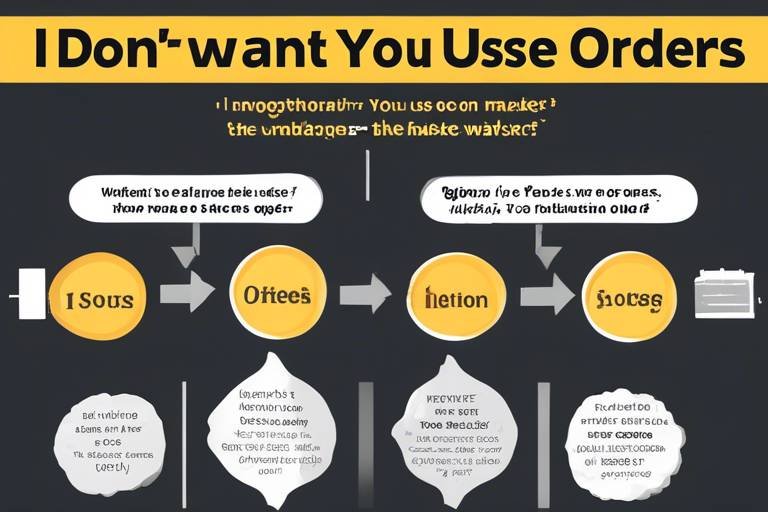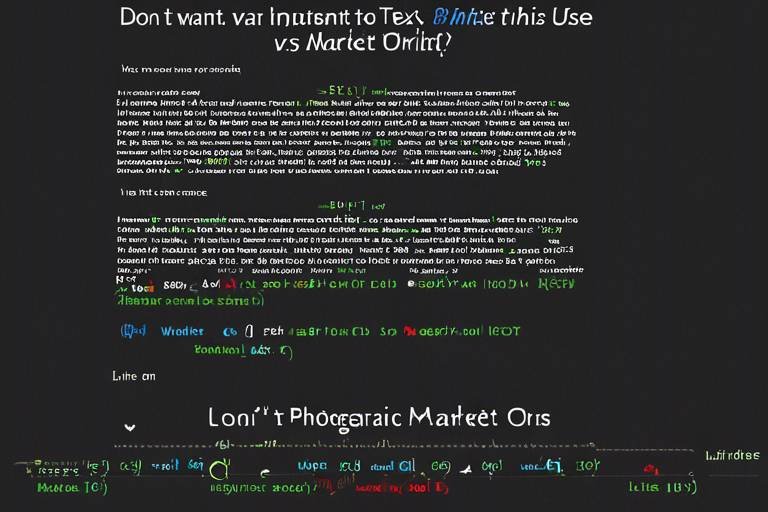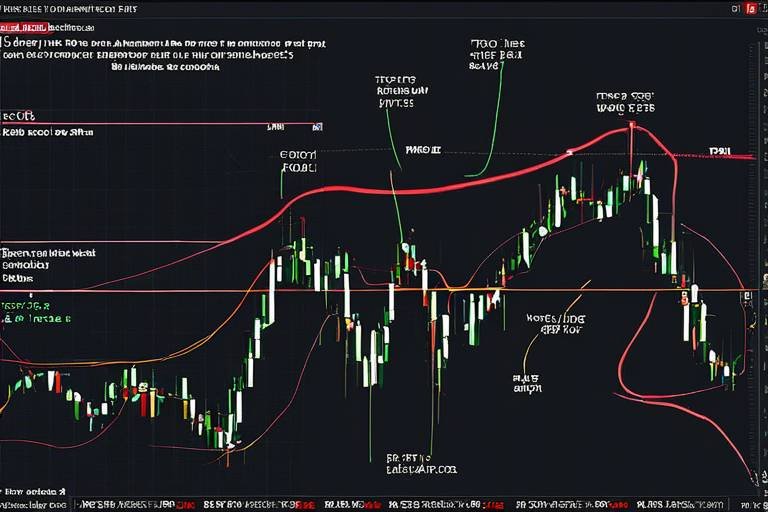Understanding Market Orders - Pros and Cons
This article explores the concept of market orders in trading, detailing their advantages and disadvantages. It aims to provide a comprehensive understanding for both novice and experienced traders.
A market order is a request to buy or sell a security at the current market price. Understanding its mechanics is crucial for making informed trading decisions. When you place a market order, you're essentially saying, "I want to buy or sell this asset right now, no matter what the price is." This can be quite liberating for traders who want to dive straight into the action without the hassle of setting specific price points. However, it’s essential to grasp how market orders work and how they can affect your trading experience.
Market orders offer several benefits, including immediate execution and simplicity. Many traders prefer this type of order in various market conditions due to these advantages. For instance, if you’re in a fast-paced trading environment, market orders allow you to enter or exit positions without delay, which can be a game changer. Let's dive deeper into why these orders are favored.
One of the primary advantages of market orders is their speed. In trading, timing is everything, and the ability to execute trades almost instantaneously can be critical. When the market is buzzing with activity, waiting for a limit order to fill can mean missing out on opportunities. Imagine trying to catch a train: if you hesitate, you might just watch it leave the station without you. Rapid execution can help traders capitalize on price swings, especially in volatile markets.
In volatile markets, the speed of market orders can help traders capitalize on price swings. For example, during earnings announcements or major news events, stock prices can fluctuate wildly within seconds. If you’re trying to buy a stock before it skyrockets or sell before it plummets, a market order can be your best friend. However, it’s crucial to remain vigilant, as the very volatility that creates opportunities can also lead to unexpected outcomes.
Market orders are often recommended for beginner traders due to their straightforward nature. New traders can find the world of trading overwhelming, with numerous terms and strategies to grasp. Market orders simplify the process by allowing them to focus on execution rather than getting bogged down in the details. It’s like learning to ride a bicycle; starting with training wheels (market orders) can make the transition smoother before tackling more complex maneuvers.
Market orders are easy to understand and execute. The user-friendly nature of market orders makes them suitable for all trading levels. You don’t need to be a rocket scientist to figure out how to place one. Simply select the asset, choose the market order option, and hit the button. It’s as simple as ordering a pizza! This ease of use is particularly appealing to those who may not have the time or desire to delve into more complicated trading strategies.
Despite their benefits, market orders have drawbacks, including potential slippage. This section explores the risks associated with using market orders in trading. While they can be advantageous, it’s essential to understand the conditions under which they may not serve you well.
Slippage occurs when the execution price differs from the expected price. This can happen in fast-moving markets where prices can change in an instant. For instance, if you place a market order to buy a stock at $50, but by the time your order executes, the price has jumped to $51, you’ve just experienced slippage. This can lead to higher costs than anticipated, impacting your overall trading strategy. To mitigate slippage, traders often recommend monitoring market conditions and placing orders during periods of lower volatility.
Large market orders can influence security prices. If a trader places a substantial market order, it can create a ripple effect, causing the price to move significantly. Imagine tossing a pebble into a calm pond; the ripples can spread far and wide. Traders should consider market impact when placing significant orders, especially in less liquid markets where a large order can drastically affect price levels.
Understanding when to use market orders can enhance trading strategies. Timing your market orders can make a big difference in your trading success. Here are some optimal scenarios to employ market orders effectively.
Using market orders during high liquidity ensures better execution prices. In liquid markets, there are many buyers and sellers, making it easier to execute trades at or near the expected price. Think of it as swimming in a busy pool; the more people there are, the easier it is to find someone to trade with.
Market orders are ideal for quick trades where timing is crucial. If you’re looking to make a fast profit or cut losses, the speed of a market order can be invaluable. In situations where every second counts, this type of order allows you to act swiftly without the need for intricate planning.
This section explores alternatives to market orders, such as limit orders and stop orders, providing insights into their advantages and when they might be preferable.
Limit orders allow traders to set specific buying or selling prices. Unlike market orders, where you accept the current market price, limit orders give you more control over trade execution. You might want to buy a stock only when it drops to a specific price. This can protect you from overpaying, but it also means your order might not execute if the price never reaches your limit.
Stop orders trigger market orders once a specified price is reached. They are commonly used for risk management. For example, you can set a stop order to sell a stock if it drops to a certain price, limiting your losses. This strategy can help you maintain discipline in your trading approach.
In conclusion, understanding market orders is essential for effective trading. Weighing their pros and cons helps traders make informed decisions tailored to their strategies and market conditions. Whether you're a seasoned trader or just starting, knowing when and how to use market orders can significantly impact your trading success.
- What is the main advantage of a market order? The main advantage is speed of execution, allowing traders to buy or sell immediately at the current market price.
- What is slippage? Slippage occurs when the execution price of a market order is different from the expected price, often due to market volatility.
- When should I use a limit order instead of a market order? Use a limit order when you want to control the price at which you buy or sell, especially in less liquid markets.
- Are market orders suitable for beginners? Yes, market orders are straightforward and easy to execute, making them ideal for novice traders.

What is a Market Order?
This article explores the concept of market orders in trading, detailing their advantages and disadvantages. It aims to provide a comprehensive understanding for both novice and experienced traders.
A market order is essentially a request to buy or sell a security at the current market price. Think of it as a fast lane in the world of trading; you get in and out quickly without the hassle of waiting. When you place a market order, you're telling your broker, "I want to buy or sell this right now, no matter the price!" This immediacy is what makes market orders so appealing, especially in fast-paced trading environments.
Understanding the mechanics of market orders is crucial for making informed trading decisions. When you place a market order, it gets executed almost instantly, provided there are enough buyers or sellers in the market. The price at which your order gets filled may vary slightly from the price you saw when you placed the order due to market fluctuations, but the key takeaway is that you will get your trade done quickly.
Market orders are particularly useful in situations where timing is more important than price. For instance, if you’re trading a stock that’s experiencing rapid price movements, a market order can help you take advantage of those fluctuations before they disappear. However, it’s essential to be aware of your trading environment, as market orders can sometimes lead to unexpected results, especially in volatile markets.
To summarize, here are some key points about market orders:
- Immediate Execution: Market orders are executed almost instantly.
- Current Market Price: They buy or sell at the best available price.
- Ideal for Rapid Trading: Perfect for traders looking to capitalize on quick price changes.

Advantages of Market Orders
Market orders are a popular choice among traders for a variety of reasons. They are particularly favored due to their immediacy and simplicity. When you place a market order, you are essentially telling your broker, “Buy or sell this security at the best available price right now!” This straightforward approach can be incredibly appealing, especially in fast-paced trading environments where every second counts.
One of the standout features of market orders is their speed of execution. In the world of trading, timing is everything. Imagine you're watching a stock that’s rapidly climbing in value. If you hesitate, you might miss out on a lucrative opportunity. By using a market order, you can jump on that price surge without delay. This is especially crucial in volatile markets, where prices can swing dramatically in a matter of moments. In these scenarios, the ability to execute a trade quickly can mean the difference between profit and loss.
Market orders excel in terms of execution speed, which is one of their primary advantages. In fast-moving markets, the ability to execute trades instantly can be vital. For instance, during a sudden market rally, prices may rise so quickly that waiting to place a limit order could result in missing the opportunity altogether. With a market order, you can secure your position immediately, ensuring that you don’t lose out on favorable price movements.
In volatile markets, where prices can fluctuate wildly, market orders can help traders capitalize on those rapid price swings. Think of it like surfing a wave; you need to catch it at just the right moment. If you’re too slow, you might wipe out. Market orders allow traders to ride those waves of volatility, enabling them to take advantage of quick price changes. For example, if a stock suddenly drops 5% due to unexpected news, a market order can help you buy at that lower price before it rebounds.
Market orders are particularly recommended for beginner traders. Why? Because they are straightforward and easy to understand. When starting out, the trading world can feel overwhelming with all its jargon and complex strategies. Market orders cut through that confusion. You don’t have to worry about setting specific prices or waiting for conditions to be met; you simply place your order and let the market do the rest. This simplicity can help ease the learning curve for new traders, allowing them to focus on understanding market dynamics rather than getting bogged down by order types.
Another reason traders love market orders is their user-friendly nature. They are easy to execute, which is essential for traders at all levels. Whether you are a seasoned pro or a novice, the process remains the same: you place your order, and it gets filled at the current market price. This ease of use makes market orders a go-to option for many, particularly when the market is active. In a world where every second counts, having a straightforward way to execute trades can be a game-changer.
In summary, the advantages of market orders—speed, simplicity, and ease of use—make them an attractive choice for traders. They allow for quick execution in fast-moving markets, making them particularly valuable during periods of volatility. For beginners, the straightforward nature of market orders can ease the initial learning curve and help them gain confidence in their trading abilities. Ultimately, understanding these advantages can empower traders to make informed decisions that align with their individual strategies.
- What is the main advantage of a market order?
The main advantage is the speed of execution, allowing traders to buy or sell securities immediately at the current market price. - Can market orders result in slippage?
Yes, slippage can occur when the execution price differs from the expected price, particularly in volatile markets. - Are market orders suitable for all traders?
While they are user-friendly and beneficial for many, market orders may not always be the best choice for traders who prioritize price precision.

Speed of Execution
When it comes to trading, the can make or break a deal. Imagine you're at a bustling auction; every second counts, and the right bid at the right moment can lead to a lucrative win. This analogy perfectly encapsulates the essence of market orders. They are designed to execute your buy or sell requests at the current market price almost instantaneously, allowing traders to seize opportunities as they arise. In fast-moving markets, where prices can fluctuate wildly within seconds, this speed is not just an advantage—it's a necessity.
Consider the scenario of a rapidly rising stock. If you wait to place a limit order, you might miss out on the opportunity as the price jumps ahead of your specified limit. Market orders, on the other hand, can help you jump in without hesitation. This capability is particularly beneficial in volatile markets, where the landscape changes quickly, and every moment counts.
However, speed doesn't come without its caveats. While market orders execute quickly, they can also expose traders to the risk of slippage. Slippage occurs when the execution price differs from the expected price due to rapid market movements. For instance, if you place a market order to buy a stock at $100, but the market price jumps to $101 before your order is filled, you end up paying more than anticipated. This phenomenon is particularly prevalent during periods of high volatility or when trading illiquid stocks.
To illustrate the impact of execution speed versus slippage, consider the following table:
| Scenario | Market Order Execution | Potential Slippage |
|---|---|---|
| Rapid Market Rally | Executed instantly at market price | Higher chance of slippage due to price jumps |
| Stable Market Conditions | Executed at the expected price | Minimal slippage risk |
| Low Liquidity | Executed but may take longer | Significant slippage possible |
In essence, while the speed of execution is a significant advantage of market orders, it is crucial for traders to remain aware of the potential for slippage. This awareness can help them make more informed decisions about when to use market orders versus other types of orders that might offer more control over execution prices. Ultimately, mastering the balance between speed and precision can be the key to successful trading.
- What is a market order? A market order is a request to buy or sell a security at the current market price.
- What are the advantages of market orders? They offer immediate execution and are simple to use, making them ideal for both beginners and experienced traders.
- What is slippage? Slippage occurs when the execution price of a market order differs from the expected price due to rapid market movements.
- When should I use market orders? They are best used during high liquidity and for quick trades where speed is more important than price precision.

In Volatile Markets
When it comes to trading in volatile markets, the phrase "time is money" couldn't be more accurate. Volatility refers to the rapid price movements that can occur in a short period, often driven by news, earnings reports, or economic data. In such scenarios, market orders can be a trader's best friend. Why? Because they allow for immediate execution at the current market price, enabling traders to seize opportunities as they arise. Imagine you're watching a stock that suddenly spikes due to a breaking news story; a market order lets you jump in without delay, potentially locking in profits before the price retreats.
However, while the speed of market orders is a significant advantage, it’s essential to remain aware of the risks associated with this approach in volatile conditions. For instance, the price at which your order is executed might differ from the price you anticipated, a phenomenon known as slippage. In a rapidly changing market, the price can fluctuate dramatically in just seconds, which means you could end up buying at a higher price than expected or selling for less than desired. This can be particularly detrimental if you're trading large volumes or if the market is experiencing extreme fluctuations.
To illustrate this, let’s consider a scenario:
- You place a market order to buy shares of a tech company after a positive earnings report.
- Due to the excitement, the stock price jumps from $50 to $55 almost instantly.
- Your market order gets executed at $55, even though you intended to buy at $50.
In conclusion, trading in volatile markets requires a fine balance between speed and risk management. While market orders provide the speed necessary to capitalize on rapid price movements, they also come with the caveat of slippage. As such, traders should carefully evaluate their strategies and consider their risk tolerance before opting for market orders in such environments.
- What is a market order? A market order is a request to buy or sell a security at the current market price.
- What are the advantages of using market orders? Market orders offer immediate execution and simplicity, making them ideal for quick trades.
- What is slippage? Slippage occurs when the execution price of a market order differs from the expected price, often due to rapid market movements.
- When should I avoid market orders? It’s advisable to avoid market orders during periods of low liquidity or extreme volatility to mitigate risks associated with slippage.

For Beginners
When it comes to trading, the world can feel a bit overwhelming, especially for beginners. However, market orders offer a straightforward entry point into the trading arena. Think of a market order as your express ticket to the trading floor – you simply indicate what you want to buy or sell, and the order is executed at the best available price. This simplicity is one of the reasons why many novice traders gravitate towards market orders.
Imagine you're at a bustling market, and you see a vendor selling fresh fruits. You don't need to haggle over prices; you just want to grab some apples quickly before they run out. Similarly, market orders allow traders to act fast, ensuring they don't miss out on opportunities. For beginners, this means less time worrying about complex calculations or market fluctuations and more time focusing on learning the ropes of trading.
Moreover, market orders are often executed almost instantly. This quick execution can be crucial for beginners who might not fully grasp the nuances of price movements yet. In fast-moving markets, every second counts, and the ability to buy or sell immediately can make a significant difference in outcomes. For instance, if a new trader spots a stock that’s trending upward, placing a market order allows them to jump on the opportunity right away, rather than risking missing out while they deliberate over the right price.
However, while market orders are user-friendly, it's essential for beginners to remain aware of their potential downsides, such as slippage. Slippage is when the price at which your order is executed differs from the price you saw when placing the order. For example, if you place a market order to buy a stock at $50, but by the time your order executes, the price has risen to $51, that's slippage. While this may sound alarming, understanding this risk can help novice traders make more informed decisions.
In summary, market orders serve as a great starting point for beginners. They provide a gateway to understanding how trading works without the complexity of other order types. By using market orders, new traders can focus on developing their strategies while gaining valuable experience in real-time market conditions. As they become more comfortable, they can gradually explore other order types, enhancing their trading toolkit.
- What is the main advantage of using market orders?
Market orders offer immediate execution at the current market price, making them ideal for quick trades. - Can I lose money using market orders?
Yes, due to slippage, the execution price may differ from the expected price, potentially leading to losses. - When should I avoid using market orders?
It's best to avoid market orders in highly volatile markets where prices can fluctuate rapidly. - Are market orders suitable for all traders?
While market orders are user-friendly, they may not always be the best choice for experienced traders who prefer more control over pricing.
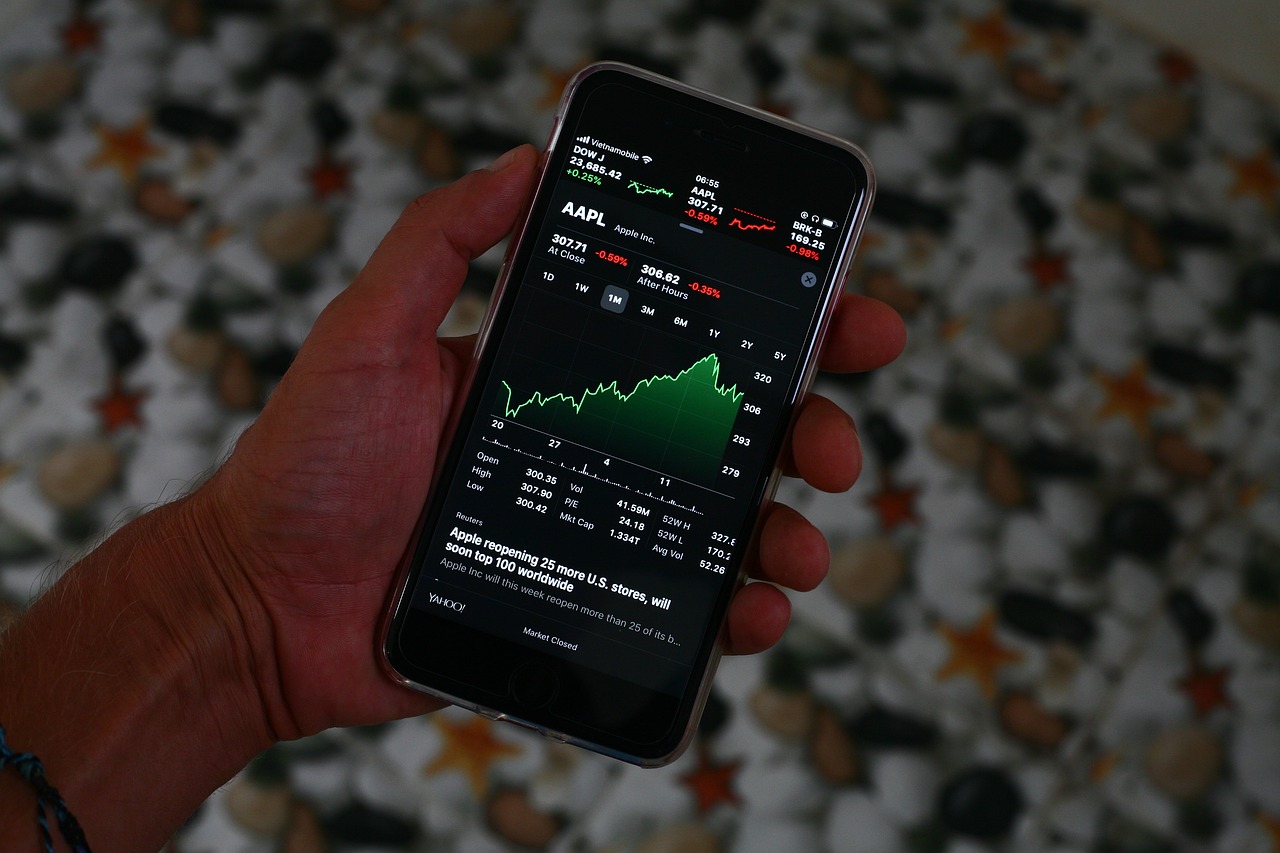
Simplicity and Ease of Use
One of the standout features of market orders is their simplicity. For anyone stepping into the world of trading, the last thing you want is a complicated process that leaves you scratching your head. With market orders, you simply decide what you want to buy or sell and place your order at the current market price. It's as straightforward as ordering a pizza—just tell the system what you want, and it delivers. This ease of use is particularly beneficial for beginners who are still learning the ropes of trading.
Unlike other types of orders that require you to specify prices or conditions, market orders take the guesswork out of the equation. When you hit that button to execute a market order, you're saying, "I want to buy or sell right now, no questions asked!" This immediacy can be incredibly reassuring, especially when you're still getting comfortable with the trading platform.
Another aspect of this simplicity is the speed at which you can execute trades. In the fast-paced world of trading, every second counts. Market orders allow you to jump in and out of positions quickly, which is crucial when you want to take advantage of fleeting opportunities. Imagine trying to catch a bus; if you hesitate, you might miss it. Market orders help you catch that bus without overthinking the process.
Additionally, market orders are universally recognized across various trading platforms. This means that whether you're using a sophisticated trading app or a basic brokerage website, the process remains consistent. You won’t find yourself lost in a sea of jargon or complex options.
To further illustrate the simplicity of market orders, consider the following table that compares them with limit orders and stop orders:
| Order Type | Execution Style | Complexity Level |
|---|---|---|
| Market Order | Executed at current market price | Very Low |
| Limit Order | Executed at a specified price or better | Medium |
| Stop Order | Triggers a market order once a specified price is reached | Medium to High |
In conclusion, the simplicity and ease of use of market orders make them an attractive option for traders at all levels. They allow for quick decision-making and execution, which can be a game-changer in the trading arena. Whether you're a newbie or a seasoned trader, embracing market orders can enhance your trading experience by minimizing the hassle and maximizing your potential for success.
- What is a market order?
A market order is an instruction to buy or sell a security immediately at the current market price. - Are market orders suitable for beginners?
Yes, due to their straightforward nature, market orders are often recommended for beginner traders. - What is slippage in market orders?
Slippage occurs when the execution price differs from the expected price, often happening in fast-moving markets. - When should I use a market order?
Market orders are best used during high liquidity periods or when you need to execute trades quickly.

Disadvantages of Market Orders
While market orders can be a trader's best friend in many situations, they also come with their fair share of drawbacks. Understanding these disadvantages is crucial for making informed trading decisions. One of the most significant concerns is slippage, which can occur when the execution price differs from what the trader expected. Imagine you’re at an auction, and you raise your paddle to bid, but by the time the auctioneer acknowledges your bid, the price has already jumped higher. This is essentially what can happen with market orders.
Slippage is particularly prevalent in fast-moving markets where prices can fluctuate rapidly. For instance, if you place a market order to buy a stock at $100, but the price jumps to $102 before your order is executed, you’ve just experienced slippage. This can significantly impact your trading outcomes, especially if you're dealing with tight margins. To mitigate slippage, traders can consider using limit orders, which allow them to set a specific price at which they are willing to buy or sell.
Another disadvantage of market orders is their potential market impact. When a trader places a large market order, it can affect the security's price, especially in less liquid markets. This is akin to throwing a large stone into a pond; the ripples can disturb the water for quite a distance. When significant orders are executed, they can lead to price movements that may not be favorable for the trader. Therefore, it’s essential for traders to consider the size of their orders relative to the market volume to avoid unintended consequences.
To illustrate these points, let’s look at a simple table that summarizes the key disadvantages of market orders:
| Disadvantage | Description |
|---|---|
| Slippage | The execution price can differ from the expected price, leading to unexpected losses. |
| Market Impact | Large orders can affect the security's price, especially in illiquid markets. |
In summary, while market orders offer speed and simplicity, they can also expose traders to risks such as slippage and market impact. It’s essential for traders to weigh these disadvantages against the benefits and consider their trading strategy carefully. In many cases, understanding when to use market orders versus other types of orders can make a significant difference in overall trading performance.
- What is slippage? Slippage occurs when the execution price of a market order differs from the expected price due to rapid market movements.
- Can market orders be used in all market conditions? While market orders can be effective in many scenarios, they are best used in liquid markets to minimize risks like slippage.
- How can I avoid slippage? To avoid slippage, consider using limit orders where you can set a specific price for your trades.
- What is market impact? Market impact refers to the effect that a large order can have on the price of a security, particularly in less liquid markets.

Slippage Risks
When it comes to trading, the term slippage might sound a bit technical, but it's crucial to understand what it means and how it can affect your trading outcomes. Simply put, slippage occurs when the price at which your market order is executed differs from the expected price. This discrepancy can happen for various reasons, but it’s most commonly seen during periods of high volatility or low liquidity.
Imagine you’re at an auction, and you raise your paddle to bid on a rare painting. You expect to pay a certain price, but before the auctioneer can finalize your bid, someone else swoops in and raises the price. When the gavel finally comes down, you end up paying much more than you anticipated. That’s slippage in a nutshell—your order is executed at a different price than you intended.
Slippage can be particularly problematic in fast-moving markets where prices can change in the blink of an eye. For instance, if you place a market order to buy a stock that’s rapidly climbing, you might find yourself paying a higher price than you were willing to accept. On the flip side, if you’re selling, you could end up getting less than you expected.
Here are a few factors that contribute to slippage:
- Market Volatility: In highly volatile markets, prices can fluctuate significantly within seconds, leading to slippage.
- Low Liquidity: When there aren’t enough buyers or sellers in the market, your order may be filled at a less favorable price.
- Order Size: Large orders can lead to slippage, as they may consume the available liquidity at the desired price level.
To mitigate slippage, traders often employ strategies such as:
- Using limit orders instead of market orders, which allows you to set a specific price for buying or selling.
- Trading during high liquidity periods, ensuring that there are enough participants in the market to fill your order at the expected price.
- Being aware of news events or economic announcements that can lead to sudden market movements.
Ultimately, while slippage is an inherent risk in trading, understanding its mechanics can help you develop strategies to minimize its impact. By being informed and cautious, you can navigate the markets more effectively, ensuring that your trading experience is as smooth as possible.
- What is slippage? Slippage is the difference between the expected price of a trade and the actual price at which the trade is executed.
- What causes slippage? Slippage can be caused by market volatility, low liquidity, and the size of the order being placed.
- How can I reduce slippage? You can reduce slippage by using limit orders, trading during high liquidity periods, and being aware of market-moving news.
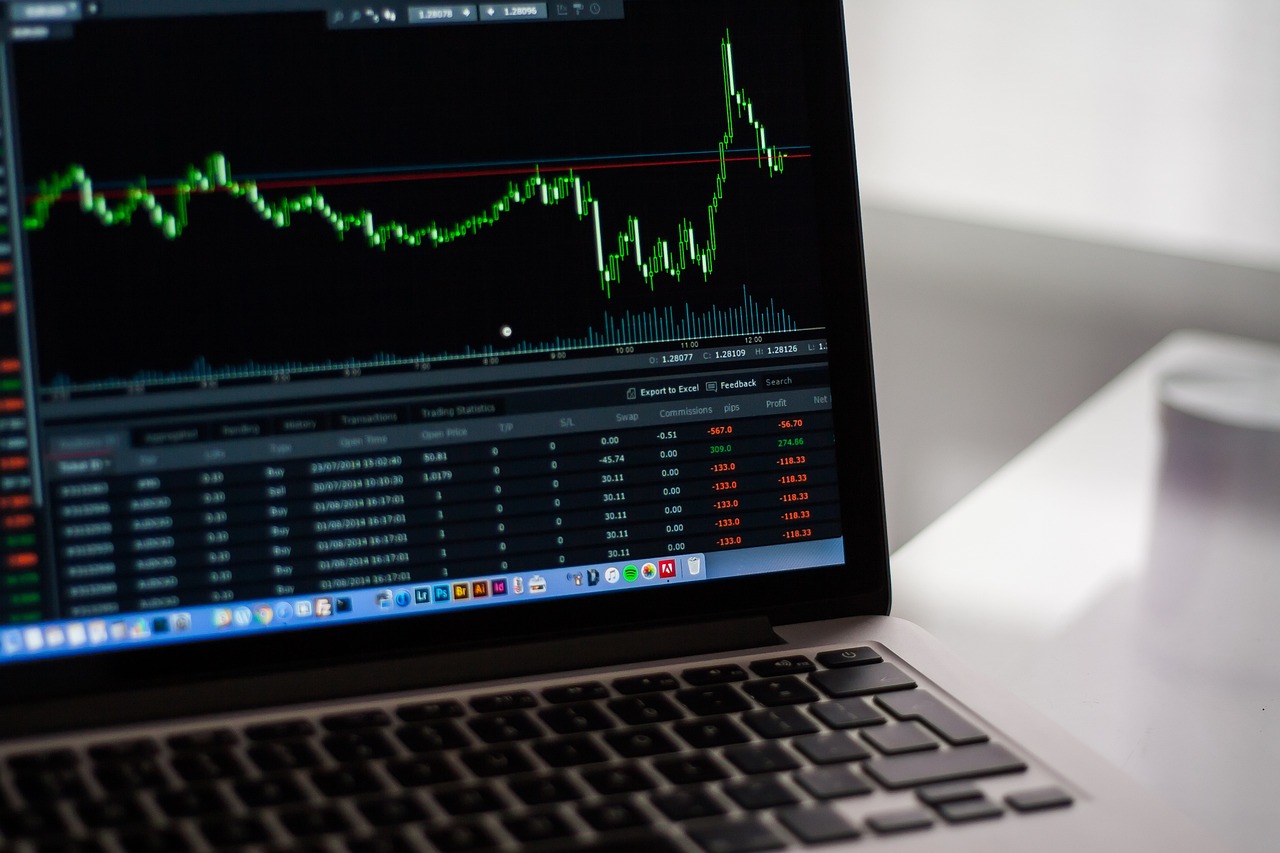
Market Impact
When placing a market order, one must consider the , which refers to how a large order can affect the price of a security. Essentially, when a trader submits a significant market order, it can shift the supply and demand dynamics, leading to price changes that may not be favorable for the trader. Imagine you're at a concert, and a sudden rush of people pushes forward; the crowd's movement can create chaos and affect how smoothly everyone gets in. Similarly, a large market order can create ripples in the trading environment.
The impact of a market order is particularly pronounced in less liquid markets, where there are fewer buyers and sellers. In these scenarios, placing a large order can lead to significant price fluctuations. For instance, if you decide to sell a large quantity of a thinly traded stock, the price might drop sharply as your order is executed, resulting in a loss compared to the price you expected. To illustrate this, consider the following table:
| Order Size | Expected Price | Executed Price | Market Impact |
|---|---|---|---|
| 100 shares | $50 | $49.50 | Negative |
| 1000 shares | $50 | $48.00 | Significant Negative |
This table highlights how the execution price can deviate from the expected price as the order size increases, leading to a more pronounced market impact. Traders should be aware that their actions can influence market prices, especially if they are trading in volumes that are large relative to the average daily trading volume of the security.
Furthermore, to mitigate market impact, traders can consider breaking larger orders into smaller ones or using limit orders instead of market orders. This strategy allows for more control over the execution price and can help minimize the negative effects on the market. In essence, being mindful of market impact is crucial for traders who wish to maintain their profitability and avoid unnecessary losses.
- What is market impact? Market impact refers to the effect that a trader's order has on the price of a security, particularly when the order is large relative to the market’s liquidity.
- How can I minimize market impact? To minimize market impact, consider breaking large orders into smaller ones, using limit orders, or trading during periods of high liquidity.
- Is market impact always negative? Not necessarily. While it can lead to unfavorable price changes, understanding and managing your orders can help you use market impact to your advantage.

When to Use Market Orders
Understanding when to use market orders can significantly enhance your trading strategy. Market orders are best suited for specific scenarios where speed and immediate execution are prioritized over price precision. If you're wondering when exactly to pull the trigger on a market order, here are some key situations to consider:
First and foremost, market orders shine during periods of high liquidity. In liquid markets, where there are numerous buyers and sellers, executing a market order usually results in better execution prices. Imagine a bustling marketplace where everyone is eager to trade; the more participants there are, the less likely you are to face drastic price changes when you place your order. This is because there are plenty of willing buyers or sellers ready to match your order at the current market price.
Another scenario where market orders are ideal is for quick trades. Picture this: you spot a fantastic opportunity, and the market is shifting swiftly. You need to act fast! In such situations, waiting for a better price with a limit order could mean missing out on a profitable trade altogether. Market orders allow you to jump in instantly, making them perfect for those critical moments when timing is everything.
However, it's essential to be aware of your trading environment. Market orders are less favorable in volatile markets, where prices can swing wildly in a short period. If you're trading in such conditions, you might want to consider other order types to mitigate risks. But if you’re confident about the direction the market is heading, a market order could still be your best bet.
In summary, using market orders effectively involves a keen understanding of market conditions. Here’s a quick recap of when to use them:
- During high liquidity to ensure better execution prices.
- For quick trades where timing is crucial.
- When you have a strong conviction about market direction, especially in volatile markets.
By keeping these factors in mind, you can make informed decisions about when to utilize market orders, ensuring that your trading strategy remains robust and effective.
Q: What is a market order?
A market order is a request to buy or sell a security at the current market price, allowing for immediate execution.
Q: When should I avoid using market orders?
Market orders should be avoided in highly volatile markets where prices fluctuate rapidly, as they may lead to unfavorable execution prices.
Q: Are market orders suitable for beginners?
Yes, market orders are often recommended for beginners due to their simplicity and ease of use, helping to ease the learning curve.
Q: How can I minimize slippage when using market orders?
To minimize slippage, consider placing market orders during high liquidity periods when there are many buyers and sellers available.
Q: Can market orders impact the market price?
Yes, large market orders can influence security prices, especially in less liquid markets, so it's important to be cautious with significant trades.

During High Liquidity
When it comes to trading, timing is everything, and one of the best times to use market orders is during periods of high liquidity. But what exactly does that mean? In simple terms, high liquidity refers to a market condition where there are plenty of buyers and sellers, making it easier to enter and exit positions without significantly affecting the price. Imagine a bustling marketplace where everyone is eager to trade; this is what high liquidity feels like in the financial world.
Utilizing market orders in a liquid market can lead to more favorable execution prices. Why is that? Because when there are many participants, your order is more likely to be filled at or near the current market price. This is crucial in fast-moving markets where prices can change in the blink of an eye. For example, if you're trading a popular stock like Apple or Tesla during peak trading hours, the chances of your market order being executed quickly and at a good price are significantly higher.
Moreover, trading during high liquidity can help mitigate some of the risks associated with market orders, such as slippage. Slippage occurs when your order is executed at a price different from what you expected, often due to a lack of available orders at your desired price. In a liquid market, the abundance of orders helps to minimize this risk. To illustrate, consider the following table that compares the execution of market orders in high vs. low liquidity conditions:
| Condition | Execution Price | Slippage Risk |
|---|---|---|
| High Liquidity | Near Market Price | Low |
| Low Liquidity | Far from Market Price | High |
In summary, trading during high liquidity not only enhances the chances of executing your market orders at desirable prices but also reduces the risks associated with slippage. This makes it a smart strategy, especially for those who are looking to capitalize on quick price movements. So next time you're considering placing a market order, check the liquidity of the market first. It could make all the difference!
- What is the best time to trade for high liquidity? Typically, the best times are during market open and close, as well as during major economic announcements.
- Can I use market orders for all types of securities? Yes, but be cautious with less liquid securities, as they may have higher slippage risks.
- How can I check market liquidity? You can look at trading volumes, bid-ask spreads, and the number of active orders to gauge liquidity.

For Quick Trades
When it comes to trading, timing is everything. The financial market can shift in the blink of an eye, and if you're not ready to act quickly, you might miss out on a golden opportunity. This is where market orders shine brightly. They are the go-to choice for traders who need to enter or exit positions without delay. Imagine trying to catch a bus that’s about to leave; you wouldn’t want to waste time negotiating a fare, right? Similarly, in trading, you want to seize the moment without getting bogged down by the details.
Market orders are particularly effective in scenarios where speed is more valuable than precision. For instance, if a stock is surging due to breaking news, placing a market order allows you to jump on that momentum immediately. This is crucial in fast-paced environments where prices can change dramatically within seconds. The thrill of buying low and selling high can often depend on your ability to act swiftly, and market orders facilitate that.
However, it's essential to recognize that quick trades come with their own set of considerations. While market orders can get you in and out of positions rapidly, they may not always guarantee the price you expect. This is especially true in cases of high volatility. A stock might be trading at $50, but by the time your order is executed, it could be at $50.50 or even $49.75. Thus, while speed is king, it’s wise to remain aware of the potential price shifts that can occur.
To sum it up, if you’re looking to make quick trades, market orders are your best friend. They allow you to capitalize on fleeting opportunities, but always keep an eye on the market conditions to ensure that your strategies align with the inherent risks of speed. After all, in the world of trading, being fast can lead to great rewards, but it’s the informed trader who ultimately thrives.
- What is a market order? A market order is a request to buy or sell a security at the current market price without any delay.
- When should I use a market order? Use market orders when you need to execute a trade quickly, especially in high liquidity situations.
- What are the risks of using market orders? The primary risks include slippage, where the execution price differs from the expected price, and market impact for large orders.
- Can market orders be used in volatile markets? Yes, but be cautious, as prices can change rapidly, leading to unexpected execution prices.

Alternatives to Market Orders
While market orders are popular for their speed and simplicity, they are not the only option available to traders. Understanding the alternatives can help you tailor your trading strategy to fit your specific needs and risk tolerance. Two of the most common alternatives to market orders are limit orders and stop orders. Each of these order types serves a unique purpose and can be beneficial in different trading scenarios.
Limit orders allow traders to specify the exact price at which they want to buy or sell a security. This means that if you set a limit order to buy a stock at $50, the order will only be executed if the stock's price reaches that level or lower. This can be particularly advantageous in volatile markets where prices fluctuate rapidly. By using limit orders, you gain more control over your entry and exit points, potentially enhancing your profit margins while minimizing losses.
On the other hand, stop orders are designed to manage risk and protect your investments. A stop order becomes a market order once the specified price is reached. For instance, if you own a stock currently priced at $60 and you want to limit your losses, you might set a stop order at $55. If the stock price falls to $55, your stop order will trigger, and the stock will be sold at the next available market price. This mechanism can help you avoid significant losses in a declining market.
To summarize the differences between these order types, here’s a quick comparison:
| Order Type | Execution Price Control | Market Impact | Best Use Case |
|---|---|---|---|
| Market Order | None; executed at current market price | Can cause slippage | When immediate execution is needed |
| Limit Order | Yes; executed at specified price or better | Less impact on market prices | When price control is essential |
| Stop Order | None until stop price is reached; then becomes market order | Can cause slippage | To limit losses or protect profits |
In addition to limit and stop orders, traders might also consider using trailing stop orders. These are similar to stop orders but allow for a dynamic exit strategy. With a trailing stop, the stop price adjusts as the market price moves in your favor, locking in profits while still providing a safety net against significant losses. This can be an excellent way to maximize gains in trending markets while maintaining a level of risk management.
Ultimately, the choice between market orders and their alternatives depends on your trading style, goals, and the specific market conditions you are facing. By carefully considering your options and understanding their implications, you can make more informed decisions that align with your trading strategy.
- What is the main advantage of using a limit order?
A limit order allows you to control the price at which your trade is executed, potentially increasing your profitability. - How does a stop order protect my investment?
A stop order automatically sells your security when it falls to a certain price, helping to limit losses. - Can I use market orders in volatile markets?
Yes, but be cautious of slippage, which can occur when the execution price differs from the expected price.

Limit Orders Explained
A limit order is a powerful tool in a trader's arsenal, allowing them to set specific prices at which they want to buy or sell a security. Unlike market orders, which execute immediately at the current market price, limit orders provide traders with the ability to control their entry and exit points. This means that you can avoid the pitfalls of unfavorable price movements that can occur in fast-paced markets. Imagine you’re at a flea market, and you see a vintage lamp you love. You wouldn’t just pay whatever the vendor asks, right? Instead, you’d negotiate a price you’re comfortable with. That’s essentially what limit orders allow you to do in trading.
When placing a limit order, you specify two key components: the price at which you want to buy or sell and the quantity of the security you wish to trade. For instance, if you want to buy shares of a company but believe the current price is too high, you can set a limit order at your desired price. The order will only execute if the market reaches that price or better. This feature not only helps you stick to your trading strategy but also shields you from the emotional rollercoaster that can come with trading.
However, while limit orders offer more control, they come with their own set of challenges. For example, if the market price never reaches your limit, your order may remain unfilled, and you could miss out on a potentially profitable trade. It’s a bit like waiting for the perfect moment to buy that vintage lamp; if you wait too long, someone else might snatch it up! Therefore, it’s essential to balance your desire for control with the reality of market dynamics.
To illustrate how limit orders work, consider the following
| Scenario | Limit Order Price | Market Price | Order Status |
|---|---|---|---|
| Buy Limit Order | $50 | $55 | Unfilled |
| Sell Limit Order | $60 | $58 | Unfilled |
| Buy Limit Order | $50 | $48 | Filled |
This table shows different scenarios involving limit orders. In the first two cases, the orders remain unfilled because the market price did not reach the specified limit price. However, in the last scenario, the buy limit order was filled because the market price dropped to $48, below the limit price of $50.
In conclusion, limit orders are an essential aspect of trading that can offer greater control over your trades. They can help you buy low and sell high, aligning with your trading strategy. However, it’s crucial to understand the market conditions and be aware that while limit orders can protect you from unfavorable prices, they may also prevent you from executing trades if the market doesn't meet your conditions. As with any trading strategy, balancing control with market realities is key to successful trading.
- What is the main difference between a market order and a limit order?
A market order executes immediately at the current price, while a limit order only executes at a specified price or better.
- Can I place a limit order for any security?
Yes, limit orders can be placed for most securities, but availability may depend on the brokerage platform.
- What happens if my limit order is not filled?
If the market price does not reach your limit price, the order will remain open until it is either filled or canceled.
- Are there any fees associated with limit orders?
Fees can vary by brokerage, so it’s essential to check with your trading platform regarding any potential costs.
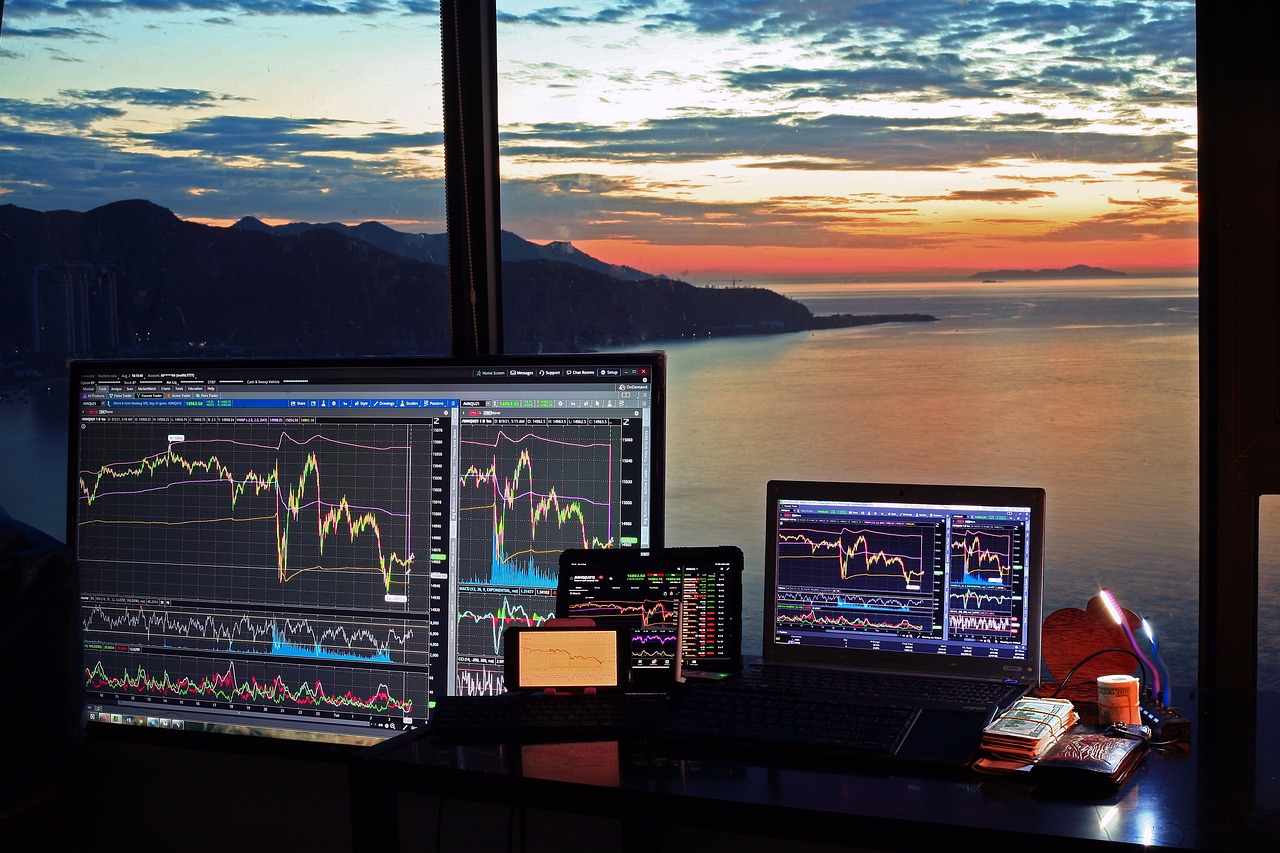
Stop Orders Overview
A stop order is an essential tool in a trader's arsenal, designed to help manage risk and automate trading strategies. When you place a stop order, you're essentially saying, "If the price hits this level, execute my trade." This can be particularly useful in volatile markets where prices can swing wildly in a short period. But how does it work, and why should you consider using it?
Stop orders come in two primary types: stop-loss orders and stop-limit orders. A stop-loss order is executed as a market order once the trigger price is reached, while a stop-limit order becomes a limit order at the specified price. This distinction is critical because it determines how your order will be executed in a rapidly changing market. Let’s break this down further:
| Type of Stop Order | Execution Method | Best Use Case |
|---|---|---|
| Stop-Loss Order | Market Order | To limit losses in a declining market |
| Stop-Limit Order | Limit Order | To control the price at which you buy or sell |
One of the significant advantages of using stop orders is the ability to set your trades and walk away, knowing that your strategy is in place. Imagine you're at work or enjoying a day out, and the market takes a turn. With a stop order in place, you can rest easy, confident that your trade will execute according to your predefined parameters, even if you're not actively monitoring the market.
However, it’s essential to understand that stop orders are not foolproof. In highly volatile markets, the price might skip over your stop-loss level, leading to a worse execution price than anticipated. This phenomenon is known as slippage, and it’s something every trader should be aware of. So, while stop orders can provide a safety net, they are not a guarantee against losses.
In conclusion, stop orders are a powerful tool for risk management and can play a crucial role in your trading strategy. By understanding how they work and the different types available, you can effectively use them to protect your investments and enhance your trading efficiency.
- What is the primary purpose of a stop order? Stop orders are primarily used to limit losses or protect profits by automatically executing a trade when a specified price is reached.
- Can I modify a stop order once it's placed? Yes, most trading platforms allow you to modify or cancel your stop orders at any time before they are executed.
- Are stop orders suitable for all traders? While stop orders can benefit many traders, they are particularly useful for those who cannot monitor the markets continuously.

Conclusion
In conclusion, understanding market orders is essential for effective trading. These orders, while straightforward, come with their own set of advantages and disadvantages that every trader should consider. By weighing the speed of execution and simplicity against potential risks like slippage and market impact, traders can tailor their strategies to better suit their individual needs and the ever-changing market conditions.
For beginners, market orders can serve as a solid entry point into the world of trading, allowing for quick and simple transactions without the complexities of other order types. However, as traders gain experience, it becomes crucial to understand when to pivot to other order types like limit or stop orders to enhance control and manage risk more effectively.
Ultimately, the decision to use market orders should be guided by the specific trading scenario at hand, including factors such as market liquidity and the urgency of the trade. By keeping these elements in mind, traders can optimize their trading strategies and navigate the financial markets with greater confidence.
- What is a market order?
A market order is a request to buy or sell a security at the current market price, ensuring immediate execution. - What are the main advantages of market orders?
The primary advantages include speed of execution and ease of use, making them ideal for quick trades. - What is slippage?
Slippage occurs when the execution price of a market order differs from the expected price, which can affect the profitability of a trade. - When should I use a market order?
Market orders are best used during high liquidity or when you need to execute a trade quickly. - What are alternatives to market orders?
Alternatives include limit orders, which allow traders to set specific prices, and stop orders, which trigger market orders once a specified price is reached.
Frequently Asked Questions
- What is a market order?
A market order is a request to buy or sell a security at the current market price. It’s the simplest type of order and is executed immediately at the best available price.
- What are the advantages of using market orders?
Market orders offer several benefits, including speed of execution and ease of use. They are ideal for traders who want to enter or exit positions quickly without worrying about setting specific prices.
- What is slippage and how does it affect market orders?
Slippage occurs when the execution price of a market order differs from the expected price, often due to market volatility. This can impact trading outcomes, especially in fast-moving markets.
- When should I use market orders?
Market orders are best used during high liquidity when you need to execute trades quickly. They are particularly useful for short-term trades where timing is more important than price precision.
- Are there alternatives to market orders?
Yes, alternatives include limit orders and stop orders. Limit orders allow you to set a specific price for buying or selling, while stop orders trigger a market order once a certain price is reached.
- Can market orders impact the market price?
Yes, placing large market orders can influence the price of a security, especially in less liquid markets. Traders should be cautious about the potential market impact of their orders.
- Why are market orders recommended for beginners?
Market orders are straightforward and easy to understand, making them a great choice for beginner traders. They allow novices to focus on learning trading strategies without getting bogged down by complex order types.

